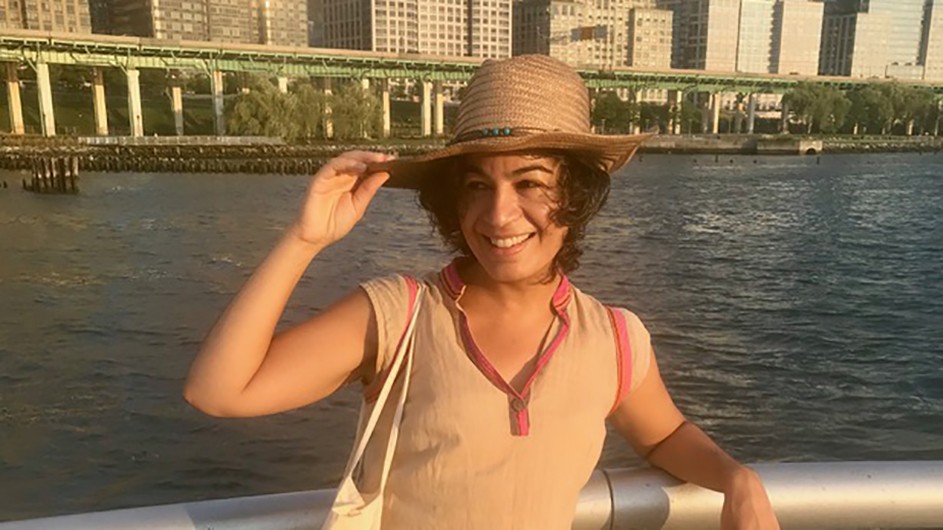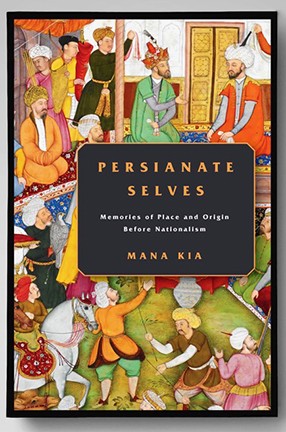What It Means to Be Persian
In Persianate Selves, Professor Mana Kia explores the complex legacy of Persia and Iran.

For centuries, Persian was the language of power and learning across Central, South, and West Asia, and Persians received a particular basic education through which they understood and engaged with the world. Not everyone who lived in the land of Iran was Persian, and Persians lived in many other lands as well. Thus to be Persian was to be embedded in a set of connections with people we today consider members of different groups.
In her new book, Persianate Selves: Memories of Place and Origin Before Nationalism, Professor Mana Kia, who teaches in the Department of Middle Eastern, South Asian, and African Studies, examines the concept of Persianate selfhood against a broader range of possibilities than contemporary nationalist claims allow.
Kia elaborates on these views with Columbia News, and also shares what books she treasured receiving as gifts, and why she finds poetry one of the most effective means of communication now.
Q. What gave you the idea for this book?
A. Part of it is personal. I was fascinated with my maternal family’s background, which didn’t seem to fit with the more dominant nationalist stories of being Iranian. My maternal grandparents migrated to Iran when they were in their early twenties from British Burma, shortly before the end of colonial rule. More strikingly, there was a blanket denial that they had interacted or intermarried with the society and culture around them, even though quite a lot of evidence pointed to the contrary. This denial was a product of colonial racism, which was deeply consonant with post-World War II Pahlavi nationalism of Iran.
After I read Amitav Ghosh’s novels, I grew curious about South Asia’s Persianate past. When I began reading those sources, I found an intriguing story, but one that we didn’t have the language to describe. The main question of my book stemmed from there: What did it mean that Persian was the language of power and learning across West and South Asia just before the rise of modern nationalism?

Q. In the book, how do you trace possibilities for Persian selfhood that are more expansive than those dictated by the nationalist tendencies of modern Iran and/or the modern autonomous individual?
A. I looked at a wide range of what I call commemorative texts, which remember people and places. They are more usually called memoirs, travelogues, biographical compendiums, or chronicles. I found enough overlap in their intertextuality, form, and stated purpose to read them together. In doing so, I compared works written in Iran with those written in India, and also those that circulated widely with those that had smaller audiences.
Persianate Selves examines how people and places are described through a close and careful reading to pull out a shared hermeneutical ground upon which agreements and disagreements were conducted. The idea was to clear away a set of explicit and implicit protonationalist assumptions—that national identities before nationalism determined how people saw themselves and others—to explore the logics according to which people actually saw themselves in earlier times. In the process, I realized that I also needed to historicize place, origin, and belonging, to avoid reinscribing the modern empiricism that governs our own analytic categories.
Q. Historically, what other parts of Asia did Persia encompass in terms of education, language, power, and culture?
A. One of the important premises of my book is that Persia is only a place in European languages, and to continue using it creates unnecessary and unhelpful confusion about who is a Persian and what that meant. Persians are not people from a place called Persia. In the languages outside of Europe, Iran is a region, consisting of a set of smaller lands, after which kingdoms have at times been named and encompassed.
Persians, by contrast, were a group of people whose various degrees of education in a corpus of Persian language texts gave them a form of being in the world. These texts began to be written in what is now Central Asia, Afghanistan, and the eastern Iranian province of Khurasan in the 10th century, but the use of Persian and the production and circulation of a wide variety of texts began to spread to other regions, like South Asia, Anatolia, and Inner Asia, over the centuries that followed. We can speak of a high Persianate period, from about 1300 to 1850, when this reach was at its greatest, though the tradition and its uses pervaded societies and cultures quite differently.
Q. What was the best book you ever got as a present and why?
A. That’s a hard one. I must acknowledge my Aunt, University of Illinois English Professor Zohreh Sullivan, for always giving me books. But, maybe because they are so hard to get (thanks to our government’s longtime policy of “crippling sanctions”), I treasure the books from Iran the most. University of Chicago Professor Alireza Doostdar once did me the enormous favor of tracking down and bringing back a number of Persian books, critical editions of manuscripts. The one I love the most was Hazin Lahiji’s Divan, a poetic collection. Most people love his ghazals (poems), but in Divan are some of the most evocative qasidas, or odes, I’ve ever read.
Q. What was your favorite childhood book?
A. Robin McKinley’s The Hero and the Crown. It’s about a girl who did not fit, who was awkward, viewed with suspicion, and found lacking, and who did her own thing anyway, which included fighting dragons and defeating evil magicians. Can you tell that I did not exactly fit the mold of a good Iranian girl in the immigrant community in Los Angeles in which I grew up? I recently reread it over the summer with my 10-year-old daughter.
Q. What is your favorite reading spot?
A. My armchair, in front of the window in my dining room. Otherwise, the beach on a warm day, though that often ends in napping.
Q. What are you teaching this semester?
A. I am teaching a course called Transregional. It first posits the problems that have been raised by adopted de facto nation-state or regional studies boundaries, such as Eurocentrism, in topic and approach across the humanities and social sciences. We then spend the rest of the semester exploring the alternatives provided by various transregional approaches, such as oceanic studies, connected histories, world literature, etc. I pushed my second course to the summer A term because of the difficulties of pandemic parenting and the utter chaos of schools, childcare, and work.
Q. You're hosting a dinner party. Which three academics or scholars, dead or alive, do you invite and why?
A. I would love to invite Angela Davis, Tahareh Qurrat al-‘Ayn, and Forough Farrokhzad. The latter is not a scholar, but one of the most moving Persian poets of 20th-century Iran. Her poetry eloquently and experimentally speaks to many frustrations and aspirations of being a woman. Tahereh was trained as a scholar in the early 19th century, and was a revolutionary, part of the Babi movement. She also wrote exquisite poetry, in a more classical style.
Angela Davis, the only one of these women still alive, is one of the most important activists and thinkers in the United States today. I met her in college, when she came to teach for a semester. She was utterly arresting, in both the power of her demeanor, and in her intellect.
As you can see, the two most prominent things on my mind right now are social and political justice, as well as poetry. I’ve always had a particular affinity for poetry, one that I never developed professionally, but which I now find a strong pull to, as other forms of communication increasingly seem undermined or ineffective.